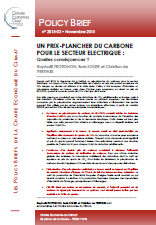
How should the EU ETS be reformed following the Paris agreement and Brexit?
by Christian de Perthuis, Boris Solier and Raphaël Trotignon
On 30 June 2005, six months after the launch of the European emissions trading system, the CO2 allowance price stood close to €30 per tonne. Eleven years later, it has fallen to €5/t. The market is no longer delivering short-term emissions reduction, including in the electricity sector, where it is more profitable to use coal than natural gas as fuel in generating plants. Successive reforms, adding stop-gap solutions to a system that was falling apart, have produced further complexity without bringing visibility.
To make the system functional again, the situation must first be correctly diagnosed. In this Policy Brief we explore three possible paths, that differ according to the role assigned to the instrument within the framework of the European climate strategy – a strategy that needs to be reassessed following the Paris Climate Agreement and in view of the new institutional framework resulting from Brexit.
- Diagnosis: a series of dysfunctions stemming from the problem faced by the public authority of setting an emissions cap that generates sufficient scarcity. Rethinking the market requires clear decisions on the real level of constraint resulting from setting an emissions cap according to the objectives targeted. Three logics are possible:
- The CO2 allowances trading system as a complement to national policies and as warning indicator: a simplified EU ETS open to the outside. In this configuration, the price of CO2 is no longer the “cornerstone” of European policy to reduce the cost of climate action, but is a complementary instrument indicating the extent to which objectives have been met.
- Refocusing the system on the goal of low-carbon transition in the electricity sector. The simplest way to achieve this would be to set a floor price on emissions from the European electricity sector, allowing the substitution of gas for coal in existing power plants. Such a scenario would change the current system into a pseudo-tax mechanism for the power generation system by making emissions from the industrial sector free.
The CO2 price signal as a key variable in the transition. To make the CO2 price the cornerstone of European climate strategy, the system needs to evolve into a hybrid instrument where the market price is constrained by a floor and a ceiling, coupled with increased coordination between national policies and European objectives given the CO2 price trajectory.
